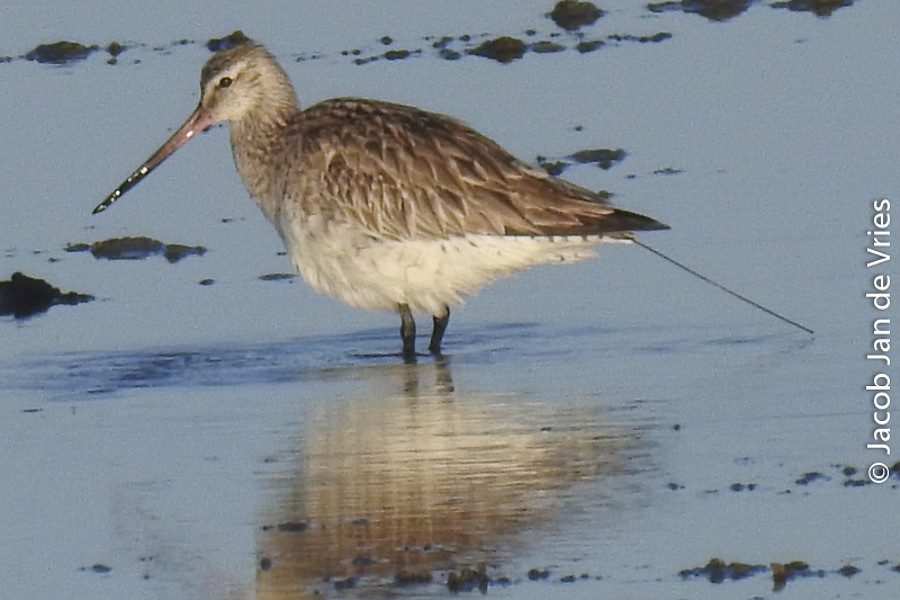FOR ENGLISH VERSION: SEE BELOW
Tekst: Rob Buiter

Gezenderde rosse grutto gespot
Naast de kanoeten zijn ook zes rosse grutto’s via satellietzenders te volgen op deze site (‘barg’ voor bar-tailed godwit*, gevolgd door het nummer van hun zender) ‘Net als de kanoeten laten deze vogels aan het begin van hun trek naar de Waddenzee al mooie verrassingen zien’, vertelt onderzoeksleider Theunis Piersma.
Beproefde techniek
De vogels met een gewicht van twee tot maximaal vier ons, dragen zenders van vijf gram bij zich. ‘Het zijn al iets oudere modellen dan de twee-grams zenders van de kanoeten, en daarmee wat meer beproefd’, vertelt Piersma. De zes dieren laten in de eerste weken een keurig patroon zien wat je van een rosse grutto mag verwachten: vertrek rond eind april uit West-Afrika, om vervolgens in de Waddenzee de tank te vullen.’
Trek over zee
Tegelijk leveren ook de zenders van de rosse grutto’s dus direct al een prachtige verrassing. ‘We kregen van waarnemers uit Frankrijk al berichten dat ze veel minder rosse grutto’s zagen dan normaal. Onze satellietvogels vertellen waarom. Bijvoorbeeld de vogel met zendernummer 54 heeft een route genomen die behoorlijk ver over de oceaan liep. Met een bocht over de zuidwestkust van Engeland is zij uiteindelijk in de Waddenzee gearriveerd. Waarschijnlijk heeft deze keuze te maken met een overheersende oostelijke luchtstroom die in die periode heeft geheerst.’
Kustlijn
‘Ik heb in het verleden wel eens gegrapt dat de trek van deze vogels een relatief makkie is’, lacht Piersma. ‘Ze hoeven maar de kustlijn van West-Afrika en het westen en noorden van Europa te volgen om in hun broedgebied te komen. Deze satellietvogels laten nu zien dat dit veel te simpel is gedacht. Het gaat uit van onze beperkte zintuigen, die misschien een kustlijn zouden willen volgen. Maar deze vogels trekken blijkbaar net zo makkelijk over open zee, terwijl ze daar overduidelijk toch een intern kompas en een gps kunnen volgen. Trekvogels zijn enorme navigatiekunstenaars en wij zitten nog maar aan het prille begin van het begrip hóe ze dat doen.’
Bewijsplaatje
Deze week kwam ook weer een prachtig bewijs dat de satelliet niet liegt: vogel ‘barg_54’ werd door Jacob de Vries en Chris Grobbe gezien door de telescoop, op het wad bij Terschelling waar op dat moment ook de zender werd gepeild. ‘We zagen een vogel met een antenne op de rug’, vertelt een opgetogen De Vries, ‘en hebben net zo lang gewacht tot hij met z’n poten boven het water uit kwam om de kleurringen af te kunnen lezen. Het bleek uitgerekend de vogel die met zo’n ruime bocht over de oceaan naar de Waddenzee was gekomen!’
*Waar onze nationale vogel, de ‘weidegrutto’ een zwarte bovenkant van de staart heeft (Black-tailed godwit in het Engels), heeft de rosse ‘kustgrutto’ een zwart-wit gestreepte staart: bar-tailed in het Engels.
ENGLISH VERSION
Bar-tailed godwit with sat-tag spotted
Bar-tailed godwit with sat-tag spottedIn addition to the red knots, six bar-tailed godwits can also be followed by satellite transmitters on this site ('barg' for bar-tailed godwit *, followed by their channel number). Like the knots, these birds immediately surprise us at the beginning of their migration to the Waddenzee", says principal researcher Theunis Piersma.
Proven technique
The birds weighing two to four hundred grams carry five grams of transmittor. 'These are already older models than the two-gram transmitters of the knots, and therefore tested more often,' says Piersma. In the first few weeks, the six animals show the pattern that you might expect from a bar-tailed godwit: leave around West Africa late April, then fill the tank in the Wadden Sea. '
Migrating over the sea
At the same time, the transmitters of the bar-tailed godwits already provide a wonderful surprise. 'We were told by observers from France that they saw far less bar-tailed godwits than usual. Our satellite birds tell why. For example, the bird with channel number 54 has taken a route that ran quite far across the ocean. With a turn across England's southwest coast, she finally arrived in the Wadden Sea. It probably has this choice with a predominant eastern air flow that has dominated that period. '
Coastline
'Once I joked that that the migration of these birds is just a piece of cake', Piersma says with a smile. 'They only have to follow the coastline of West Africa and the west and north of Europe to arrive at their breeding area. These satellite birds now show that this is too simple reasoning. It shows how we judge from our limited senses, and would have anticipated on following a coastline. But these birds seem to travel just as easy about the open sea, while they obviously can follow an internal compass and a gps. Avian migrants are tremendous navigational artists and we are still at the beginning of understanding how they do it.'
Field evidence
Again this week a beautiful proof was presented that the satellite is not lying: bird 'barg_54' was seen by Jacob de Vries and Chris Grobbe by the telescope, on the mudflat near Terschelling where the transmitter was also gauged at that moment. 'We saw a bird with an antenna on its back,' says a delighted De Vries, 'and waited for as long as he got out of the water with his legs to read the colorrings. It was apparently the bird that had come across the ocean to the Wadden Sea with such a wide bend! '
* Where our national bird, the 'field godwit' has a black top of the tail (hence Black-tailed godwit), the bar-tailed ‘coastal godwit’ has a black and white striped tail: hence bar-tailed godwits.